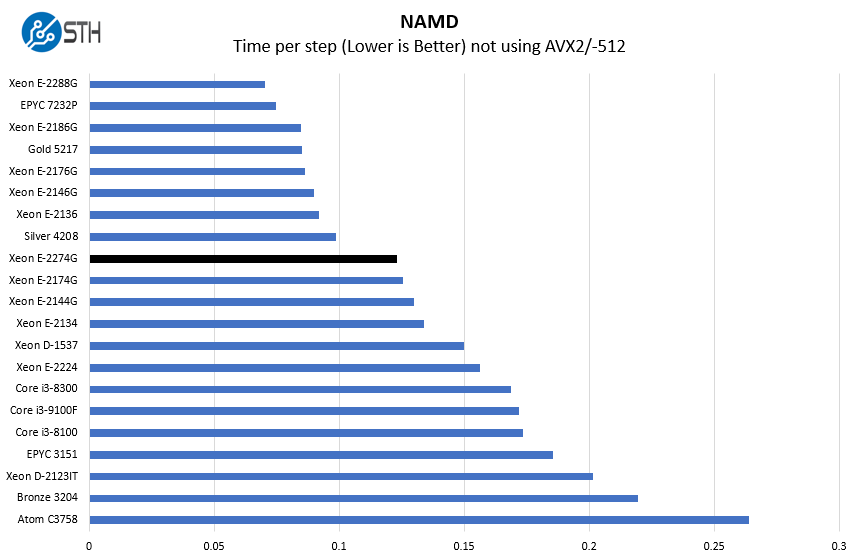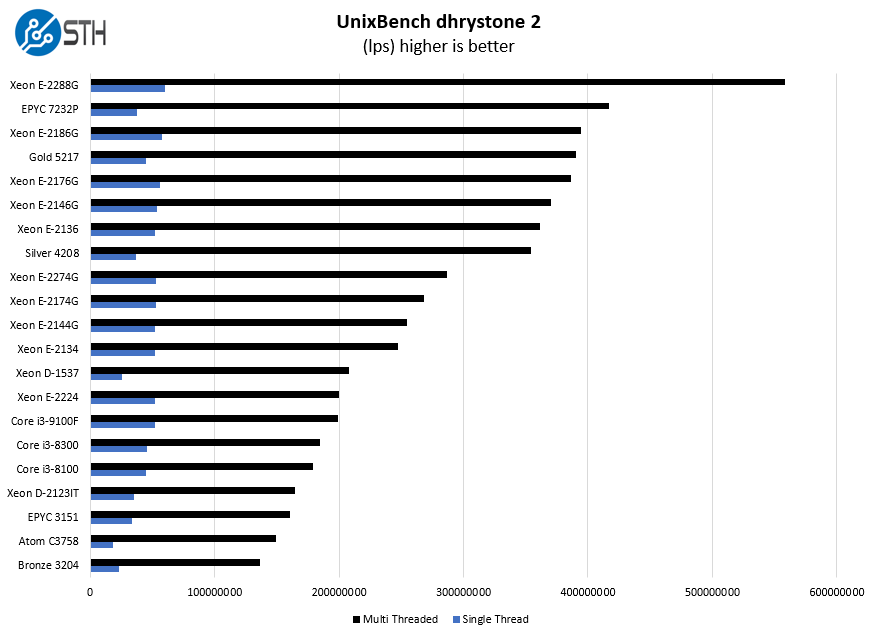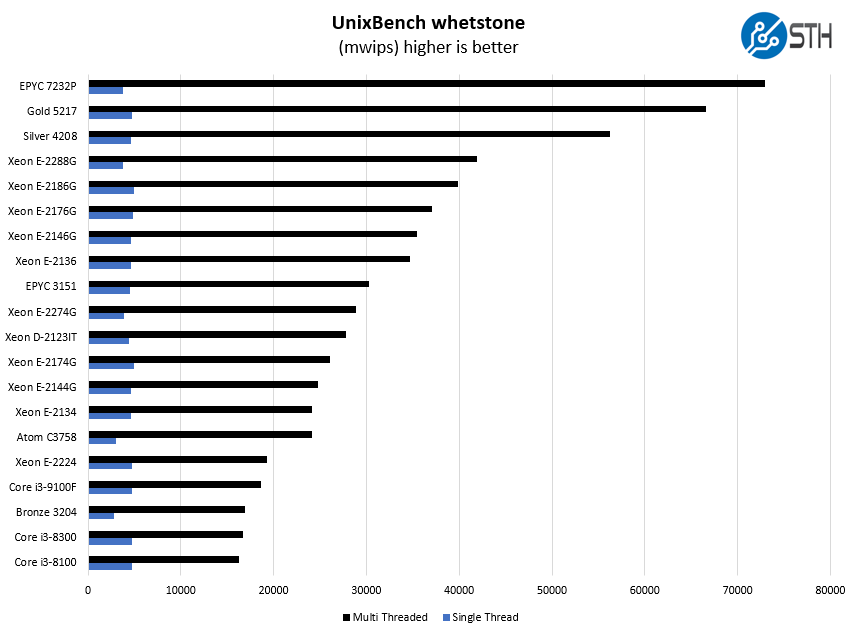Intel Xeon E-2274G Benchmarks
For this exercise, we are using our legacy Linux-Bench scripts which help us see cross-platform “least common denominator” results we have been using for years as well as several results from our updated Linux-Bench2 scripts. At this point, our benchmarking sessions take days to run and we are generating well over a thousand data points. We are also running workloads for software companies that want to see how their software works on the latest hardware. As a result, this is a small sample of the data we are collecting and can share publicly. Our position is always that we are happy to provide some free data but we also have services to let companies run their own workloads in our lab, such as with our DemoEval service. What we do provide is an extremely controlled environment where we know every step is exactly the same and each run is done in a real-world data center, not a test bench.
We are going to show off a few results, and highlight a number of interesting data points in this article.
Python Linux 4.4.2 Kernel Compile Benchmark
This is one of the most requested benchmarks for STH over the past few years. The task was simple, we have a standard configuration file, the Linux 4.4.2 kernel from kernel.org, and make the standard auto-generated configuration utilizing every thread in the system. We are expressing results in terms of compiles per hour to make the results easier to read:

AMD generally does not try to compete in this space, but we did want to point out the AMD EPYC 7232P. It is only about $100 more for the CPU and it also comes with additional platform costs. At the same time, the EPYC 7232P is in a different class in terms of expandability. If you are trying to build a system with a large number of disks, NICs, or accelerators, yet need minimal processing power, the EPYC 7232P is a considerably better platform, as are the Intel Xeon Silver 4208 chips.
c-ray 1.1 Performance
We have been using c-ray for our performance testing for years now. It is a ray tracing benchmark that is extremely popular to show differences in processors under multi-threaded workloads. We are going to use our 8K results which work well at this end of the performance spectrum.

On our c-ray benchmark, we see that the Xeon E-2274G is quite a bit faster than the Xeon E-2224 which is a 4 core/ 4 thread part. Threads still matter for performance especially in workloads like this.
7-zip Compression Performance
7-zip is a widely used compression/ decompression program that works cross-platform. We started using the program during our early days with Windows testing. It is now part of Linux-Bench.

Here, the 200MHz benefit over the previous generation Intel Xeon E-2174G is noticeable, but it is also a benefit that should make one take pause. Even if you were to upgrade from the Xeon E-2144G in the previous generation, it is a relatively modest gain. Again, at the same price point, additional performance is welcome. At the same time, without enormous architectural gains, and keeping similar core/ clock speeds, these are not enormous generational gains.
NAMD Performance
NAMD is a molecular modeling benchmark developed by the Theoretical and Computational Biophysics Group in the Beckman Institute for Advanced Science and Technology at the University of Illinois at Urbana-Champaign. More information on the benchmark can be found here. We are going to augment this with GROMACS in the next-generation Linux-Bench in the near future. With GROMACS we have been working hard to support Intel’s Skylake AVX-512 and AVX2 supporting AMD Zen architecture. Here are the comparison results for the legacy data set:

Here we can see a step function which is really intriguing. While the E-2274G is the fastest quad-core part, six and eight-core parts are significantly faster. Indeed, where this gets strange is that the Intel Xeon E-2136 is significantly faster as a previous generation and lower cost part. It does not have the onboard GPU but has a 3W lower TDP even with more cores. If you do not need the integrated GPU, the E-2136 is a better value even as an older generation part.
Sysbench CPU test
Sysbench is another one of those widely used Linux benchmarks. We specifically are using the CPU test, not the OLTP test that we use for some storage testing.

Here we have an interesting result with the Intel Xeon E-2288G with 8 cores and 16 threads showing about twice the performance. That shows how much expandability there is in the same socket as the Xeon E-2274G.
OpenSSL Performance
OpenSSL is widely used to secure communications between servers. This is an important protocol in many server stacks. We first look at our sign tests:

Here are the verify results:

We wanted to call attention to the delta between the Xeon E-2274G and the Intel Xeon D-2123IT. The Xeon D-2123IT is Intel’s primary embedded performance part today that also has lower clock speeds. Here, the Xeon E part provides significantly more performance.
UnixBench Dhrystone 2 and Whetstone Benchmarks
Some of the longest-running tests at STH are the venerable UnixBench 5.1.3 Dhrystone 2 and Whetstone results. They are certainly aging, however, we constantly get requests for them, and many angry notes when we leave them out. UnixBench is widely used so we are including it in this data set. Here are the Dhrystone 2 results:

Here are the whetstone results:

Here we see a very similar pattern to the rest of the chips in the market. We wanted to highlight the delta between the E-2274G and the Intel Atom C3758. Even though each has eight threads, the higher clock speed and more robust architecture of the Xeon E series yields noticeably more performance albeit at higher power consumption.
GROMACS STH Small AVX2/ AVX-512 Enabled
We have a small GROMACS molecule simulation we previewed in the first AMD EPYC 7601 Linux benchmarks piece. In Linux-Bench2 we are using a “small” test for single and dual socket capable machines. Our medium test is more appropriate for higher-end dual and quad-socket machines. Our GROMACS test will use the AVX-512 and AVX2 extensions if available.

When we are using AVX pipelines, the generational improvement is much smaller. The E-2274G was still faster than its predecessor if only by a small margin.
Chess Benchmarking
Chess is an interesting use case since it has almost unlimited complexity. Over the years, we have received a number of requests to bring back chess benchmarking. We have been profiling systems and are ready to start sharing results:

The chess benchmarking shows a very interesting result. Here, the AMD EPYC 7251, an 8 core 16 thread embedded part yields notably more performance. The EPYC 7251 is an older embedded part that uses less power and has more I/O. That AMD EPYC part is not socketed so it is not a direct competitor. It still shows what and AMD entrant into this market could do.
Next, we are going to have power consumption, market positioning, and our final words.




The AsRockRack X470D4U2-2T looks to be a pretty competitive.
Supports AMD AM4 Socket Ryzen™ Series CPUs
Supports 4x DDR4 ECC and non-ECC UDIMM, max. 128 GB
Supports up to 6 x SATA3 6.0Gb/s (inculded 1 SATA DOM), 2 x M.2
Integrated IPMI 2.0 with KVM and Dedicated LAN (RTL8211E)
Supports2 x RJ45 10G base-T by Intel X550-AT2
Supports 2 x PCIe 3.0 x16, 1 x PCIE 2.0 x1
Together with a same priced R7 3700x
What’s wrong with using any of the numerous am4 boards that have the traces for the full 72 bit ecc memory interface and thus support ecc udimms?
But yeah, there is absolutely no valid reason for amd to neglect the fairly easily attainable possibility to trash intel in that market too. It is understandable why they went after big money first, but now that they are dominating the high end, maybe put some effort into validation and promotion of low end servers.
4 core, 8 thread, 4.0 Ghz base clock, and 8MB of cache for $328? Is this 2014?
That’s the exact same specs as the 4790K Haswell chip from 2014, even down to the price point.
DGO the big win is Out of band IPMI Port and AST2500 BMC
Still a good chip for an application server now it’s coming down to the discount market at dedicated server hosts. Many user-facing operations can still be single-threaded, and it boosts to 4.9/4.8/4.6/4.4Ghz – though perhaps less at more power with AVX2; my system will run it at 83W for 28s. Obviously if you need AVX-512, Xeon D is the way.
There’s equivalent boards, E3C246D4U2-2T or similar – the NVMe-supporting E3C246D4I-2T was reviewed here – with the AST2500.